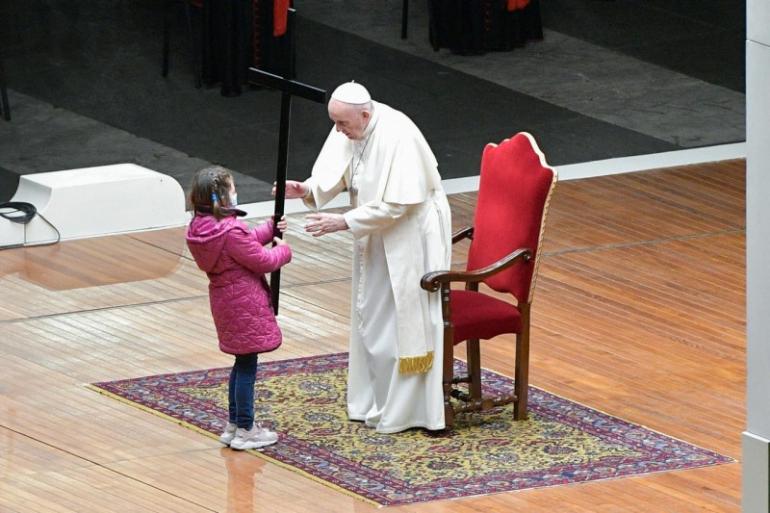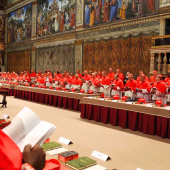Children take center stage at Vatican’s annual Good Friday service

Children took center stage during this year’s Good Friday service in the Vatican.
A group of children read the meditations, stopping 14 times around the St. Peter’s Square to mark each of the “Stations of the Cross,” starting with the first when Jesus was condemned to death by Pontius Pilate to the last when he was buried in a tomb.
The opening comments, written in the form of a child’s dialogue with Jesus, recalled children who go without food or education or are forced to be soldiers.
It also mentioned the embarrassment children feel when they wet the bed, sadness when parents fight, and the fear of telling an adult a dark secret for fear of not being believed, which appeared to be a reference to sexual abuse.
The meditations at each station attempted to relate the experiences of children to those of Jesus.
At the 13th station, when Jesus is taken down from the cross, a child recalled seeing his grandfather being taken away in an ambulance and later dying of the coronavirus.
Solitude and isolation of men and women across the world, cut off from their families and friends, deprived of their work and livelihoods, living in fear of an uncertain future for themselves and for their children, were the overarching theme of the celebration.
Pope Francis led the Good Friday “Way of the Cross” in a near-empty Square due to restrictions put in place by the Italian government to curb the spread of the new coronavirus disease.
A lonely figure in white, seated at the center of a bare stage set up in front of the Basilica, the Holy Father looked over the darkened Square where the children, accompanied by their parents, catechists and teachers, took turn carrying a cross around the obelisk.
One after the other, they read their reflections while their companions carried the cross along a circular path marked out by burning torches on the ground at the center of the Square.
For over 50 years since Pope Paul VI revived the ancient “Via Crucis” tradition in 1964, popes have led this powerful rite that re-enacts the passion and death of Jesus Christ against the backdrop of Rome’s Colosseum.
Since the beginning of the COVID-19 pandemic last year, restrictions put in place to curb infections have impacted all public events, including the traditional ritual.
The last reflection recited during Good Friday’s event highlighted how children and young people hold the key and the hope for rebirth.
“Lord, merciful Father, once again this year we have followed your Son Jesus on the way of the cross. We followed him by listening to the voices and the prayers of the children whom you yourself set before us as the model for entering your kingdom,” it said.
“Help us to be like them: little, in need of everything, open to life. May we regain our purity of heart and our ability to see things in a clear light,” read the prayer.
“We ask you to bless and protect every child in our world. May all children grow in wisdom, age and grace, and so come to know and follow your special plan for their happiness.”
Candles in the form of a huge cross dotted an empty St. Peter’s Square as about only 200 people took part, sitting on either side of the pope immediately in front of St. Peter’s Basilica.
Different groups write the meditations each year. This time they were penned by girl scouts and boy scouts from the Umbria region and pupils from a school in Rome, most of them not yet teenagers.
Earlier on Good Friday, Pope Francis prostrated himself on the floor of an empty St. Peter’s Basilica to pray at a “Passion of the Lord” service.
The pontiff is due to say an Easter vigil Mass on Saturday and on Easter Sunday, the most important day in the Christian liturgical calendar, he delivers his “Urbi et Orbi” (to the city and the world) message. - LiCAS.news
Radio Veritas Asia (RVA), a media platform of the Catholic Church, aims to share Christ. RVA started in 1969 as a continental Catholic radio station to serve Asian countries in their respective local language, thus earning the tag “the Voice of Asian Christianity.” Responding to the emerging context, RVA embraced media platforms to connect with the global Asian audience via its 21 language websites and various social media platforms.














